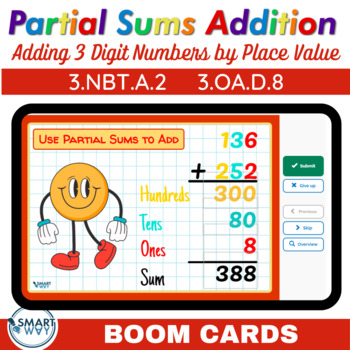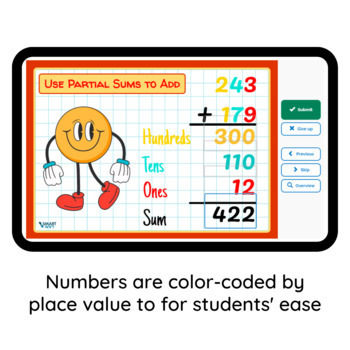Add 3-digit Numbers with Partial Sums Boom Cards 3.NBT.A.2 3.OA.D.8
- PDF
- Internet Activities
Description
Provide practice in Adding 3-digit numbers with partial sums to your Grade 3 math students with these Boom Cards. The addition is made is easy by color-coding numbers by place value. Check out these no-prep, self-checking, interactive, cute, and simple digital boom cards. A huge time-saver for the teachers. Awesome math resource for Grades 2, 3, and 4.
Add 3-digit numbers with partial sums.
This resource can be used for:
- Practice for struggling students
- A fun activity for early finishers
- Online lessons, distance learning, eLearning
- At-home practice, homework
- Math centers, Math station
Boom Cards are:
- Self-correcting (students will know automatically if their answer is correct or wrong).
- Paperless (no need for paper)
- Digital (they can be played on mobile, tablets, and laptops)
- Easy to use.
To use Boom Cards, you must be connected to the Internet. Boom Cards play on modern browsers (Chrome, Safari, Firefox, and Edge). Apps are available for modern Android, iPads, iPhones, and Kindle Fires. For security and privacy, adults must have a Boom Learning account to use and assign Boom Cards. You will be able to assign the Boom Cards you are buying with "Fast Pins," (a form of play that gives instant feedback to students for self-grading Boom Cards). For assignment options that report student progress back to you, you will need to purchase a premium account. If you are new to Boom Learning, you will be offered a free trial of our premium account. Read here for details: http://bit.ly/BoomTrial
****************************************************************************************
Need more Boom Cards for your 3rd Grade Math Center?
Elapsed Time Boom Cards 3.MD.A.1
Multiplication Facts Fluency Boom Cards Bundle
3 Digit Subtraction with Regrouping Boom Cards 3.NBT.A.2, 3.OA.D.8
Add Up to Four 2 and 3-digit Numbers Boom Cards 3.NBT.A.2, 3.OA.C.7, 3.OA.D.8
Add 3 Digit Numbers with Regrouping 3.NBT.A.2 3.OA.D.8
Missing Factors and Products in Multiplication Table for Fact Fluency
****************************************************************************************
Stay Connected:
Like me on Facebook
Follow me on Instagram
Take a look at my Pinterest
Follow me on TPT
Follow my store at Boom Learning




